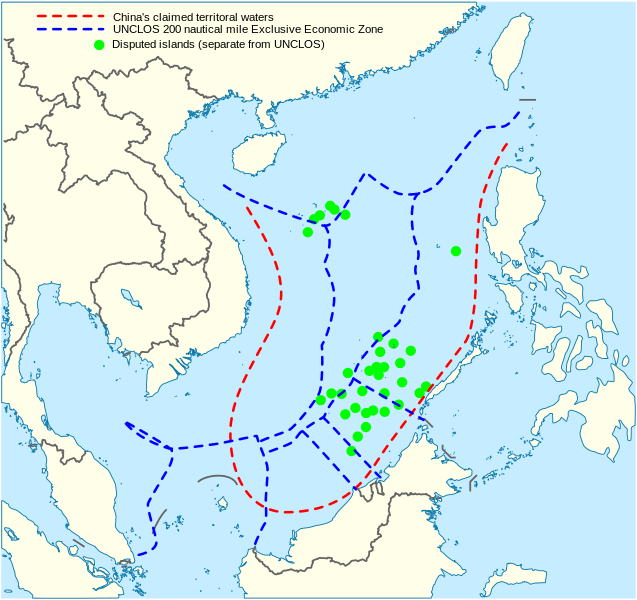By Merel Alstein
Tensions in the South and East China Seas are high and likely to keep on rising for some time, driven by two powerful factors: power (in the form of sovereignty over and influence in the region) and money (from the rich mineral deposits that lurk beneath the disputed waters). Incidents, such as the outcry over China’s recently announced Air Defence Identification Zone, have come thick and fast the last few years. One country’s historic right is another country’s attempt at annexation. Every new episode in turn prompts a wave of scholarly soul-searching as to the lawfulness of actions taken by the different countries and the ways that international law can, or cannot, help resolve the conflicts.

Maritime claims in the South China Sea by Goran tek-en. CC-BY-SA-3.0 via Wikimedia Commons.
In order to help keep track of debate in blogs, journals, and newspapers on the international law aspects of the various disputes, we have created a debate map which indexes who has said what and when. It follows on from our previous maps on the use of force against Syria and the prosecution of heads of state and other high-profile individuals at the International Criminal Court. Blog posts in particular have a tendency to disappear off the page once they are a few days old, which often means that their contribution to the debate is lost. The debate maps reflect a belief that these transient pieces of analysis and commentary deserve to be remembered, both as a reflection of the zeitgeist and as important scholarly contributions in their own right.
To help readers make up their own minds about the disputes, the map also includes links to primary documents, such as the official positions of the countries involved and their submissions to the UN Commission on the Limits of the Continental Shelf.
One striking aspect of the map is how old some of the articles are, originating from the early 1970s. Controversies which seem new now actually go back some 40 years. In conflicts such as these, which cannot be understood without their history and where grievances often go back centuries, this awareness is key.
Another surprising feature is the uncertainty surrounding the legal basis of China’s claim to sovereignty over most of the South China Sea—its famous nine-dash line. Semi-official or unofficial statements by Chinese civil servants, or in one case by the Chinese Judge at the International Court of Justice, are seized on as indications of what China’s justifications are for its expansive maritime claims. A clearer official position, and more input from Chinese scholars, would significantly improve the debate.
Ultimately, the overlapping maritime claims and sovereignty disputes in the South and East China Seas are unlikely to be solved any time soon, and will keep commentators busy for years to come. We will keep the map up to date to facilitate and archive the debate. Your help is indispensable: please get in touch if you have any suggestions for improvements or for new blog posts and articles we can link to.
Merel Alstein is a Commissioning Editor for international law titles at Oxford University Press. She recently compiled a debate map on disputes in the South and East China Seas. Follow her on Twitter @merelalstein.
Oxford Public International Law is a comprehensive, single location providing integrated access across all of Oxford’s international law services. Oxford Reports on International Law, the Max Planck Encyclopedia of Public International Law, and Oxford Scholarly Authorities on International Law are ground-breaking online resources working to speed up research and provide easy access to authoritative content, essential for anyone working in international law.
Subscribe to the OUPblog via email or RSS.
Subscribe to only law articles on the OUPblog via email or RSS.
The post Sovereignty disputes in the South and East China Sea appeared first on OUPblog.



